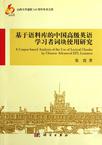基于语料库的中国高级英语学习者词块使用研究
出版时间:2012-5 出版社:科学出版社 作者:张霞 页数:199
内容概要
词块集中体现了语言使用中规约性与创新性的辩证统一,词块使用特征往往提示出文本构成的机制以及学习者的语言能力特征。本书设计了二套行之有效的词块抽取和赋码方案,并将之应用于中国高级英语学习者词块使用的调查分析,从结构功能和词汇语法两个层面考察了学习者和本族语者使用词块的趋势;还对学习者和本族语者、母语不同的学习者、学习者和教材用法进行了对比分析,旨在揭示学习者用法中产生偏差的内在机理,以期对教学有所启示。
《基于语料库的中国高级英语学习者词块使用研究》适合高校英语教师、语言学类研究人员、高校在读语言学类研究生及对语言量化研究感兴趣的本科生阅读。
书籍目录
总序
acknowledgements
introduction
chapter 1 lexical chunks and language description
1.1 the conventional use of language as a long-standing and
long-recognizect phenomenon
1.1.1 a de facto, long-standing and wide-spread phenomenon
1.1.2 a long recognized phenomenon
1.2 the centralization of conventional language in neo-firthian
researches
1.2.1 the difference between the functionalist and mentalist
paradigms
1.2.2 from meaning and function to the conventional use of
language
1.2.3 how neo-firthian arguments solve the problem of
productivity
1.3 lexical chunks as representing conventionality in language
use
1.3.1 the nature of lexical chunks
1.3.2 features of lexical chunks
1.4 a review of the methodology development in studies of lexical
chunks
1.4.1 the marginalization of phraseology and the salience
approach
1.4.2 the centralization of phraseology and the statistical
approach
1.4.3 altenberg, biber and the study of lexical chunks
1.5 summary
chapter 2 lexical chunks and language acquisition
2.1 a comparison
2.2 holistic language processing and fla
2.2.1 explanatory adequacy and the alternative expediency
2.2.2 holistic language processing and the route of fla
2.2.3 the role of holistic language processing in fla
2.3 lexical chunks and sla
2.3.1 differences and similarities between advanced efl learners
and first language acquiring children.
2.3.2 lexical chunks and the route of sla
2.3.3 lexical chunks and the success of sla--the social-fimctional
level
2.3.4 lexical chunks and the success of sla--the lexico-grammatical
level
2.3.5 lexical chunks and the success of sla--extant studies
2.4 procedural vocabulary and lexical chunks
2.4.1 the conception of procedural vocabulary
2.4.2 the relationship between procedural vocabulary and lexical
chunk
2.5 deviations in learners' use of lexical chunks--description and
diagnosis
2.5.1 two kinds of deviations and two approaches to the
diagnosis
2.5.2 the cia approach and the diagnosis of learner
deviations
2.5.3 the research questions of the present research
2.6 the acquisition of lexical chunks in the classroom
context
2.7 summary
chapter 3 the methodology
3.1 an nlp perspective of the study of lexical chunks
3.1.1 hybrid algorithms
3.1.2 association measures
3.1.3 statistical algorithms to decide mwu boundary
3.1.4 dispersion
3.1.5 the extraction of procedural vocabulary
3.1.6 the automatic extraction of patterns around a certain
word
3.2 the methodology of the present study
3.2.1 corpora used--size, sampling and preprocessing
3.2.2 the extraction of lexical chunks: length range, frequency,
dispersion and boundary determination
3.2.3 the filtering process
3.2.4 tools of lexical chunk extraction
3.2.5 annotation
3.2.6 the extraction of pv
3.2.7 word-form based lexical chunks and pos-tag sequences around
pv
3.3 the research design of the present study
chapter 4 word-form based lexical chunks
4.1 the proportion issue
4.2 types and tokens of lexical chunks in different length
categories
4.3 types, tokens and type/token ratio of lexical chunks in
different corpora
4.4 the structure and function characteristics of lexical
chunks
4.4.1 dependent clause
4.4.2 independent clause
4.4.3 single clause constituent
4.4.4 incomplete phrase
4.4.5 multiple clause constituents
4.4.6 the interaction between function and corpus
4.5 discussion and summary
appendix: complementary statistical analyses
chapter 5 pos-tag sequences around pv
5.1 procedural words in the four corpora
5.1.1 rank correlation analysis
5.1.2 distribution of content and function words
5.1.3 distribution of pv of various parts of speech
5.2 the relationship between procedural words and lexical
chunks
5.2.1 the proof of the close relationship between pv and lexical
chunks
5.2.2 descriptive statistics
5.3 procedural words common to the corpora under study
5.3.1 analysis of take
5.3.2 analysis of make
5.3.3 analysis of time and way
5.4 summary
appendix: complementary statistical analysis
chapter 6 major findings revisited
6.1 major findings and conclusions
6.2 limitations and prospects
6.2.1 higher degree of abstractness
6.2.2 semantic prosody and discoursal ffmctions
6.2.3 the developmental dimension
6.2.4 procedural vocabulary
references
appendix
图书封面
评论、评分、阅读与下载
用户评论 (总计1条)
- 博士论文,看看是否有所启发
